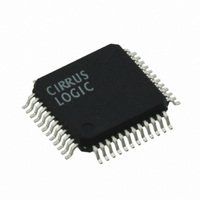CS3308-CQZ Cirrus Logic Inc, CS3308-CQZ Datasheet - Page 24

CS3308-CQZ
Manufacturer Part Number
CS3308-CQZ
Description
IC ANLG VOL CTRL 8CH DGTL 48LQFP
Manufacturer
Cirrus Logic Inc
Type
Controllerr
Datasheet
1.CS3308-CQZ.pdf
(44 pages)
Specifications of CS3308-CQZ
Package / Case
48-LQFP
Applications
High End Audio
Mounting Type
Surface Mount
Product
General Purpose Audio Amplifiers
Output Power
362 mW
Available Set Gain
22 dB
Thd Plus Noise
- 112 dB
Operating Supply Voltage
3.5 V / 5.25 V
Supply Current
36 mA
Maximum Operating Temperature
+ 70 C
Mounting Style
SMD/SMT
Audio Load Resistance
2 KOhms
Input Offset Voltage
0.75 V
Input Signal Type
Single
Minimum Operating Temperature
- 10 C
Output Signal Type
Analog
Supply Voltage (max)
5.25 V
Supply Voltage (min)
3.1 V
Output Type
8-Channel Audio
Lead Free Status / RoHS Status
Lead free / RoHS Compliant
For Use With
598-1778 - EVALUATION BOARD FOR CS5376598-1496 - BOARD EVAL FOR CS3308 VOL CTRL
Lead Free Status / Rohs Status
Lead free / RoHS Compliant
Other names
598-1598
Available stocks
Company
Part Number
Manufacturer
Quantity
Price
Company:
Part Number:
CS3308-CQZR
Manufacturer:
Cirrus Logic Inc
Quantity:
10 000
24
5.8.2
5.8.2.1
Up to 128 CS3308’s sharing the same CS signal may be connected to a common SPI serial control bus.
This shared serial bus is used to assign a unique device address to each device on the bus such that they
may be independently addressed. To implement this method of device address configuration, the devices
must be connected as shown in
Note that the serial control signals CCLK, CS, and MOSI are connected in parallel to each CS3308. The
active low reset output of the system controller is connected to the RESET input of the first CS3308 in the
chain. The ENOut of the first device is connected to the RESET input of the second CS3308 whose ENOut
signal is connected to the third CS3308. This pattern of connecting the ENOut of device N to the RESET
Serial Control within a Multiple-CS3308 System
The CS3308 allows both independent and simultaneous control of up to 128 devices on a shared I²C or
SPI serial control bus. The address of each device is configured by the host controller via the shared serial
control bus. All serial communication, including the configuration of each device’s address, adheres to a
standard I²C or SPI bus protocol.
A device’s Individual device address, which provides read and write access to the device’s internal regis-
ters, should be set to a unique value, different from all other addresses recognized by devices on the serial
communication bus. This address facilitates independent control of each CS3308 on the serial control
bus.
A device’s Group 1 and Group 2 addresses, which provide write-only access to the device’s internal reg-
isters, may be set to the same value across multiple CS3308’s on the shared serial communication bus.
Assigning common Group addresses to multiple devices in a system allows system sub-master and sys-
tem master volume control. For instance, a system containing 8 CS3308’s may configure the Group 1 ad-
dress of the first set of 4 CS3308’s to 10h, the Group 1 address of the second set of 4 CS3308’s to 20h,
and the Group 2 address of all 8 CS3308’s to A0h. In this manner, a serial control data write to address
10h would act as a system sub-master control to the first set of 4 devices, a write to 20h would act as a
system sub-master control to the second set of 4 devices, and a write to A0h would act as a system mas-
ter control to all devices.
By default, the CS3308 will not respond to serial communication when addressed with its Group 1 or
Group 2 address. The CS3308 will only respond to one or both of these addresses if the corresponding
address has been enabled via the control port. To enable a Group address, its corresponding Enable bit,
located in the LSB of its respective Group address register, must be set.
The CS3308 implements an ENOut signal to facilitate the device address configuration process. This sig-
nal is used to hold all but one un-configured device in a reset state. After the Individual device address of
each device has been set, the ENOut signal is used to enable the “next” device in the chain, allowing its
Individual device address to be set. See
“I²C Mode Control Configuration” on page 26
communication mode.
μC
MOSI
CCLK
RST
SPI Mode Serial Control Configuration
CS
RESET
Figure 9. SPI Serial Control Connections
CS
Device 1
MOSI
Figure
CCLK
ENout
9.
“SPI Mode Serial Control Configuration” section on page 24
RESET
for more information about system configuration in each
CS
Device 2
MOSI
CCLK
ENout
RESET
CS
Device 3
MOSI
CCLK
ENout
CS3308
DS702F1
and















